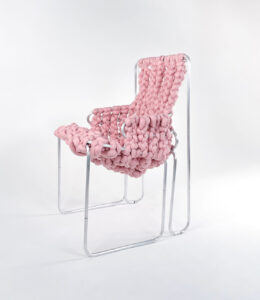During the spring semester of 2022, the Department of Architecture at the Massachusetts Institute of Technology conducted Course 4.041 — Advanced Product Design. The focus of the course was to “develop concepts of sustainability for a more ecologically-responsible and digitally-enabled future.” According to the course syllabus, students would be asked to “reinterpret and conceive of new typologies, redefining what ‘furniture’ means from the ground-up.” Today, we’re spotlighting just a handful of their future facing designs.
To make the course even more interesting, MIT teamed up with Emeco, an iconic American furniture company to provide students with access to Emeco’s manufacturing technology as they conceptualized sustainable furniture. The students’ design solutions have been dubbed The Next 150-year Chair, based on Emeco’s 1006 Navy chair developed in 1944, which, according to the manufacturer, has a “150-year lifespan.”
Associate Professor Skylar Tibbits explained that “Today, a 150-year chair means making something that lasts a long time, which is a great thing to do. But the question is whether that will be the same for the next 150 years – should the goal still be to make things that last forever? That’s one approach, but maybe there’s something that could be infinitely recyclable instead or something that’s modular and reconfigurable.”

Over the spring term, five students explored their unique approaches to answering the question. Their results featured a number of complete furniture pieces and components that were exhibited at Emeco House, the company’s converted 1940s sewing shop, in Venice, CA in late November.
María Risueño Dominguez developed a furniture component based on longevity. Her research on furniture consumption and interviews with people involved in the furniture industry resulted in a concept called La Junta – a cast-aluminum joint with multiple different inserts shaped to fit a variety of components.

Amelia Lee developed a product designed to last through different stages of childhood. It is made from a single sheet of recycled HDPE. Modeled on a rocking chair, the piece can be turned on its side to function as a table.
Zain Karsan set out to improve metal 3D printing technology for the frames of his chairs, focusing on a technique for dispensing molten material at high-speed to explore new ways to think about form and joining parts.
Faith Jones designed the ReWoven Chair, with an aluminum frame and a recycled (and replaceable) cotton sling, as an exploration into how to maintain comfort and sustainability.
Jo Pierre’s interest in maintaining comfort within dense physical settings resulted in a chair called Enhanced Privacy — a plastic partition designed for domestic spaces that includes a hanging sheet of plastic that can be filled with water to block sound and diffuse light.
As both a design process and a collaboration between academia and industry, The Next 150-year Chair Project established a refreshing model for how we might conceptualize the future of furniture while pushing the boundaries of sustainable design and novel materials.

